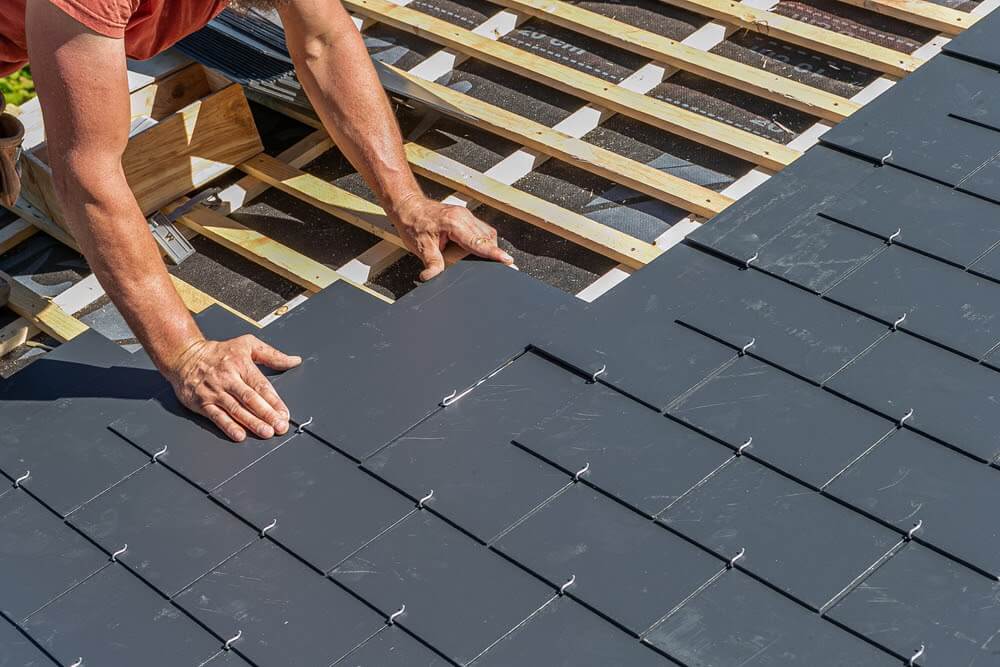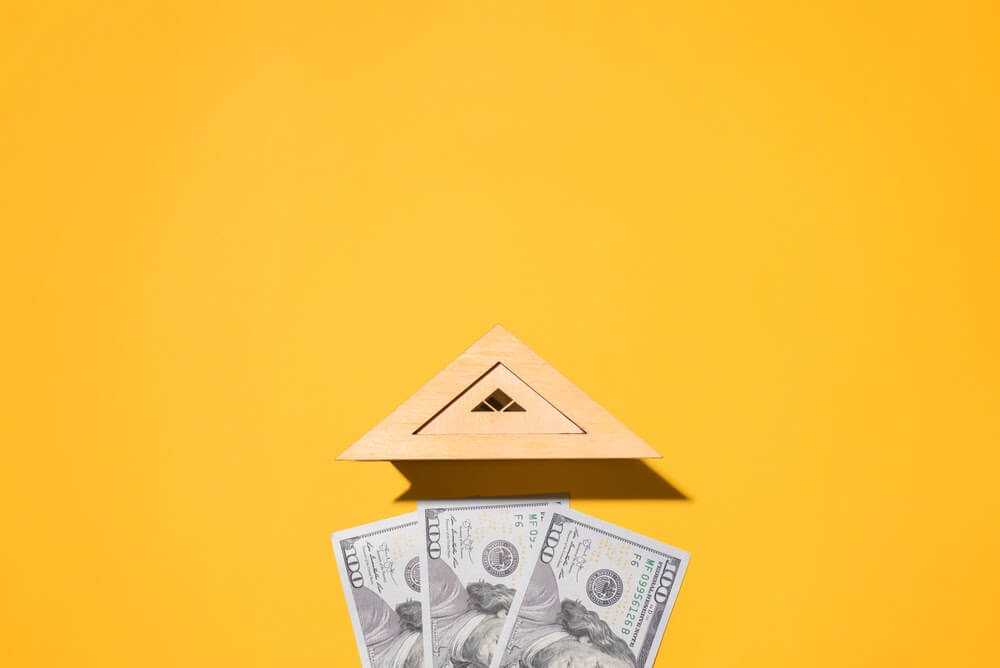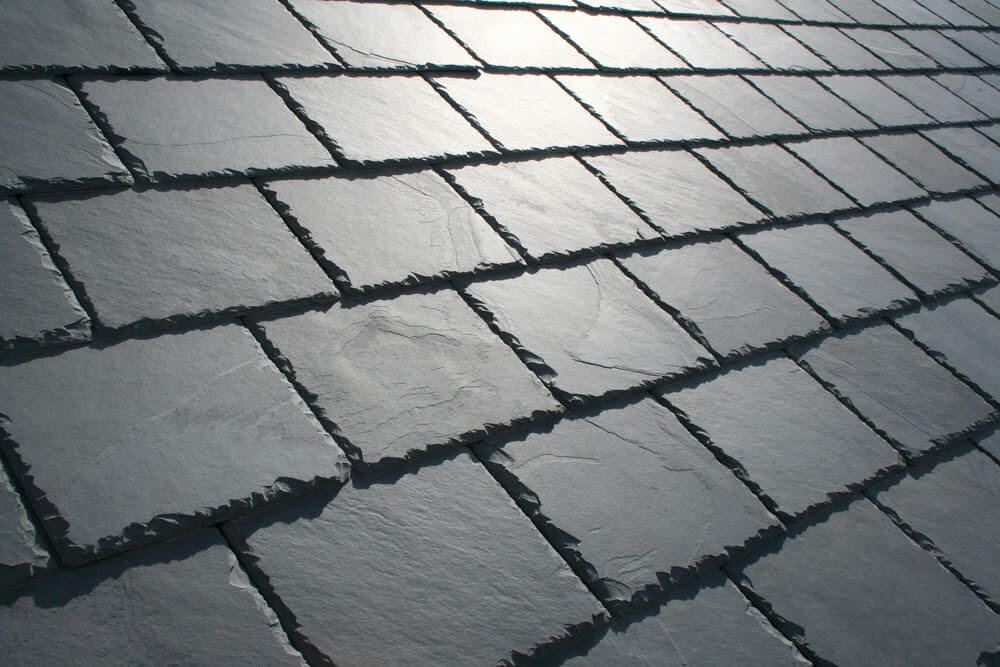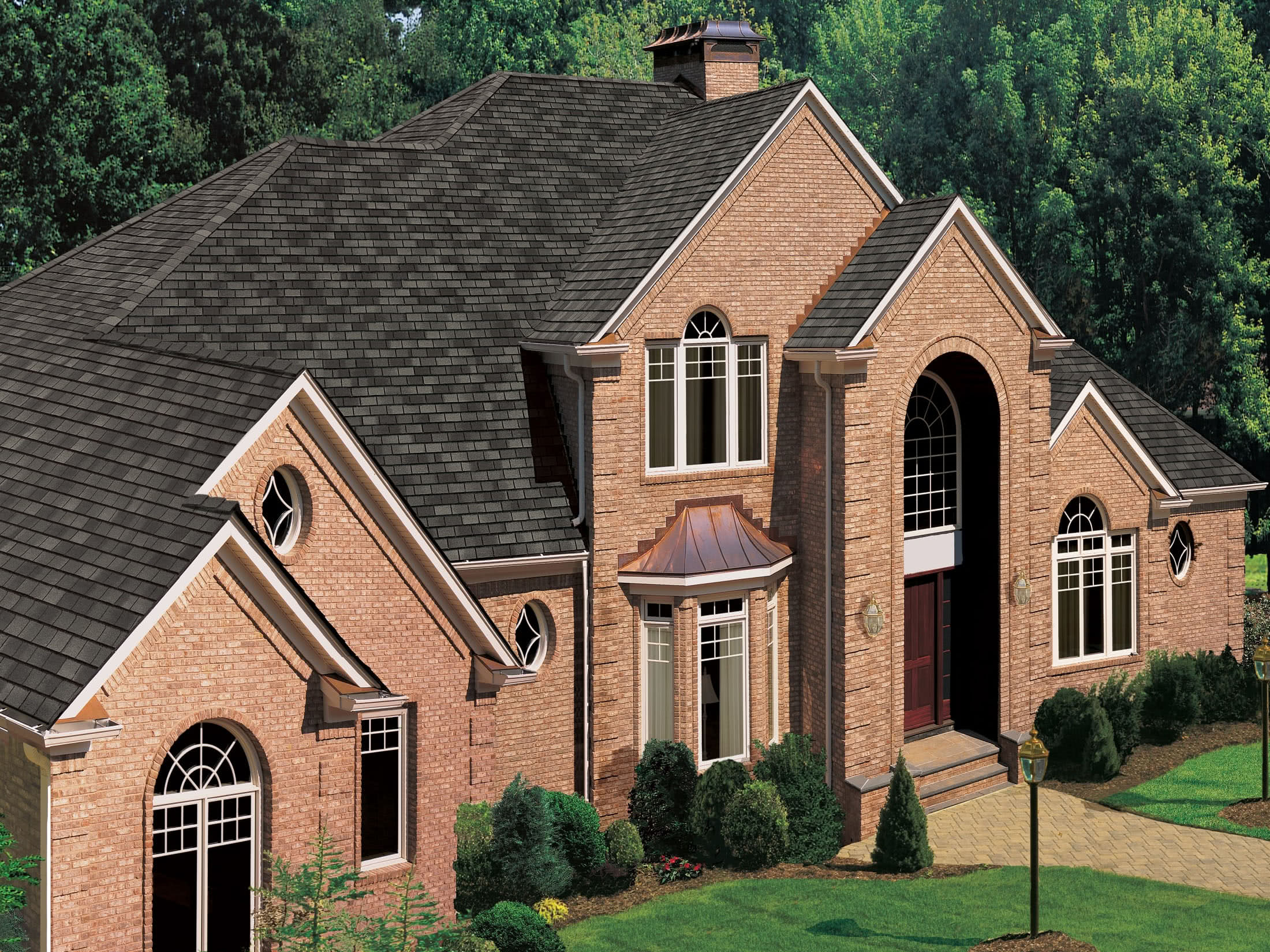Request Quote
Home | Our Blog | Slate Roof: Pros, Cons, and Cost to Install
Reviewed by Tomas Kalkys. President.
Qualifications: More than 20 years of experience in residential and commercial exterior remodeling.
Founding farther of Legacy Service.
Written by LegacyUSA Team
posted on Mar 26, 2021
Get Estimates From Roofing Pros

Slate is known as one of the longest-lasting materials used for roofing. You may be wondering if this material is right for your home. If so, you’ve come to the right place. In this article, we’ll discuss what a slate roof is, the average costs you can expect, the different types, the pros and cons, and some of the most frequently asked questions.
At Legacy Service, we provide roofing installation and replacement services for homeowners throughout Pennsylvania, New Jersey, and Delaware. If you’re interested in scheduling a free estimate for slate roof installation or replacement, get in touch with our team today.
Not a real zip code.
Slate goes back centuries as a roofing material. It’s still one of the highest-quality and longest-lasting materials on the market today. In some cases, it can last up to 200 years! However, it’s also one of the heaviest and most expensive. If you’re considering slate roofing material for your home, you’ll want to weigh your options before you make any decisions.
The appearance of this material has appealed to so many people that a replica material, which is made of rubber and other synthetic products, is sometimes used instead. It is most frequently seen in Great Britain, but it’s also been found on homes along the east coast of the United States.
If you move into a house that has this type of roofing, you may not ever have to replace it. The slate roof lifespan can last up to 200 years. If you’re looking to newly install this material on your home, remember that the cost will be more expensive than most other materials. Sometimes it can cost up to five times more than other types of materials.
The cost of slate tile roofing typically ranges from $1,000 to $3,000 per square, including materials and labor. This will convert to about $10 to $20 per square foot for soft slate and $20 to $30 per square foot for hard. Some homeowners have reported up to an $80 cost per square. Synthetic tends to cost between $5 and $10 per square foot.
Labor costs for just the installation of this roof will normally range from $5 to $15 per square foot or $50 to $100 per hour. The labor-intensive project requires specialized skills, knowledge, and experience. Synthetic can cost between $3 and $5 per square foot.
The slate roof replacement cost, which includes the removal of an old roof, can add an additional $2 to $5 per square foot to tear off the old roof. Disposal fees may also cost extra.
Depending on what you need, the cost of additional materials will usually range from $2 to $5 per square foot. Some of these can include sheathing, copper flashings and nails, bituminous membrane, weather shield, and structural reinforcement. Ask your local slate roof professionals for more information.
In most cases, synthetic slate roofing will cost less than natural. Natural roofs are heavier, which means the materials will cost more and the labor prices will be higher.
For natural slate roofs, you can expect to pay about $10 to $30 per square foot, which can total between $5,000 and $50,000 for a house. Some homeowners have even reported projects that cost up to $100,000.
For synthetic, the costs will typically range between $5 and $10 per square foot depending on the material you choose. The overall price will probably be half of what you’d pay for natural. Many people prefer synthetic for this reason.

Whether you’re installing a new roof or replacing an old one will affect the overall cost of the project. When you’re installing slate roof tiles or shingles, you’ll just need to pay for the cost of materials and labor. When you’re replacing the roof, you’ll need to pay extra to tear off and dispose of the old roof.
For both the materials and labor, you can expect to pay about $1,000 to $3,000 per square to install a natural roof. Soft slate usually costs between $10 and $20 per square foot. Hard slate is typically between $20 and $30 per square foot. And the price range for synthetic is normally between $3 and $16 per square foot.
A roof replacement costs more than just an installation. On average, it can cost you about an additional $2 to $5 per square foot to remove the old roof. You may also have to pay some sort of disposal fee. The good news is that natural can be easily recycled since it’s just stone. Roofing companies will be able to provide you with more info.
For additional materials or tools, you’ll probably add about $2 to $5 to your slate roof cost. If you’re looking for slate roofing companies near me, then you’ve come to the right place. Our team provides roofing installation and replacement services. Contact us today to schedule an appointment.
Once you’ve determined that you want a slate roof to cover your home, you’ll have to decide which type. Different styles were developed to suit local requirements in different regions around the world. In this section, we’ll discuss some of the most common types of modern slate roofs that you can choose for your house. They include:
Standard roofing systems are laid in uniformly spaced horizontal courses with carefully aligned alternating vertical joints. They consist of ¼” – ⅜” slate of one standard length and width, and they have square cut butts.
Introducing slates of different colors or shapes in a particular design creates patterned roofs. Individual banding or accents can also be used. Accents can include words, names, dates, or even geometric and floral patterns. These patterns are typically incorporated into standard roofs.
This style involves installing slates of varying lengths and widths, which came from the days when quarries would produce slate on an “as available” basis. The roofing contractor would sort the material on-site and install the longest and widest ones at the eaves and graduated multiple other lengths in courses, so the narrowest and shortest slates were at the top. A well laid-out graduated roof will show no discernible break.
Not a real zip code.
For this type, both thickness and length are graduated into the roof, starting with the largest and thickest at the eaves. Slates of three, four, or more thicknesses are usually incorporated throughout the roof, depending on how large it is. Slates at the eaves may be as thick as 1 inch, and slates at the top may be as thin as 3/16 of an inch.
Multicolored roofs are created by blending mixtures of various colors together. It’s possible to achieve this using a uniform size roof, but it’s most common through the use of random width installation. Any number of colors is possible, but most property owners use between two and four. It’s recommended to use complementary semi-weathering colors to ease the transitions.
This style shares attributes with standard installation, but it only uses slates of one length and thickness in a variety of widths. The slates are laid in courses to provide adequate joint offset without maintaining joint alignment.
A textural roof mixes slates of rougher surface textures and varying thicknesses to create an appealing, rougher-hewn appearance. Since the slates are rougher and thicker, it’s common for butt corners to be randomly missing for acceptable dimensions.
This architectural variation randomly uses longer slates; their additional length projects past the butt lines of other slates, which creates a hang-down appearance. Their heads are laid to the same course line or higher. Get in touch with local slate roofing contractors to learn more.

There’s a reason why slate roof shingles and tiles have been so popular among homeowners for centuries. Well, multiple reasons, actually! Let’s take a look at our list of the advantages of choosing this material.
If you want a roof that will last for the rest of your life, then slate may be your ideal option. This material is designed to have a lifespan of more than a century, sometimes lasting up to 150 or even 200 years. If it’s properly installed and maintained, these roofs can outlast multiple generations. In an industry where roofs tend to last about 20 or 30 years, this is an incredible lifespan.
Many homeowners are drawn to this material because of its beauty. It has one of the classiest and most celebrated appearances on the market today, and the tiles offer more choices than people may realize. They’re available in various sizes and thicknesses, and they boast a wide range of colors, including but not limited to gray, black, purple, green, red, and mottled tiles that have several colors mixed together. Whether you want to learn more about composite slate roofs or colonial slate roofs, get in touch with your local roofing company. If you’re interested in replacement or installation, contact our team to schedule a consultation.
Whether you’re living in an area that’s prone to wildfires or not, it’s reassuring to have a roof that’s fire-resistant. In fact, slate is one of the most fire-resistant roofing materials on the market today. The tiles are completely fireproof, which is a great advantage when it comes to preventing fires sparked from fireworks, adjacent house fires, or wildfires. Your local roofer can provide you with more information. If you’re looking for slate roofing contractors near me that offer free estimates, contact our team at Legacy Service.
Last but not least, slate roofs are environmentally-friendly due to two reasons. Real slate is made of all-natural materials, which is good for the environment, and it has a much longer lifespan than other types of materials, like asphalt shingles. Waste from roofing materials accounts for about 5% of total waste that’s sent to American landfills throughout the year. The majority of that can be attributed to asphalt shingles since they need to be replaced about every 15-25 years. Installing a roof that lasts 100 years or more can positively impact the environment by producing less waste.
Before you run off to install a slate roof on your home, you’ll want to first consider the disadvantages. Sure, it’s great to have a durable roof with a long lifespan, but how much are you willing to pay for it? Take a look at this list of cons before you make any decisions:
Most homeowners consider the cost of a slate roof to be its biggest disadvantage. The price will vary depending on a number of different factors, but it’s practically guaranteed that you will be paying several times more than you would for an asphalt shingle roof of the same size. The roofing cost per square can range anywhere from $1,000 to $8,000. That’s a huge initial investment for roofing tiles. Synthetic slate roof tiles usually cost less than natural, but they may still cost more than other types of materials. For a synthetic slate roofing cost estimate, contact your local contractor.
Surprisingly, plenty of roofing contractors know very little about slate. If you don’t hire roofers that are fully knowledgeable and experienced with this material, then you may be facing poor installation. When you’re hiring a contractor for this type of material, make sure you inquire about their experience and ask for references. A well-installed slate roof can last more than a century, but one that’s been installed poorly will need plenty of maintenance, which will end up costing a lot more in the long run.
Despite the long lifespan, slate roofs are actually pretty fragile. It’s best not to walk on your roof unless you know what you’re doing. Something as simple as an A/C repairman working on your rooftop can cause damage to a bunch of tiles. Even a fallen tree branch may cause expensive damage. And unfortunately, replacing broken tiles can be more difficult than it sounds. Slate comes in lots, so it’s almost impossible to find new tiles that are a perfect match.
Slate tile is a heavy roofing material. It can weigh anywhere between 800 and 1,500 pounds per square (100 square feet). Before you begin to install this material on your home, you’ll need to have a professional evaluate it from a structural standpoint to see if it can handle the weight.
Synthetic is another story. In some cases, it can weigh about a quarter of real slate. If you’re wondering about the best synthetic slate roofing for your home, get in touch with your local roofing company. Contact us to schedule a free estimate for roof installation or replacement.

If you choose to install full or partial slate roofing on your home, it’s recommended that you choose a company that will provide maintenance work, if needed. In many cases, the maintenance work will be covered under warranty. Every company has a different policy, so you’ll want to check with the one you choose to find out the type of issues they cover as well as the length of their warranty.
The good news is that it requires little to no maintenance since it doesn’t warp, rust, or attract mold. It’s also unlikely to be damaged by storms or hurricanes. Just make sure you trim branches that could land on it and cause damage and avoid walking on your roof as much as possible.
As for slate roof cleaning, it’s best to schedule regular cleanings to help maintain the appearance and structural integrity of your roof. Hire an experienced slate roof cleaner to remove debris and wash the tiles with a gentle cleaning solution. Cleaning your natural slate roof will help it last even longer.
Sometimes, real slate just won’t cut it for a homeowner. Whether the reason is that it’s too costly, too heavy, or too fragile, it may be time to look for an alternative.
If you love the appearance of this material but don’t want the real deal, we recommend looking into composite slate roof tiles (also known as synthetic). From ceramic to recycled rubber slate roofing, these alternatives provide an option that’s less expensive but still has a long lifespan (up to 75 years for some materials).
Although alternatives are no replacement for natural when it comes to authenticity and value, especially in historical homes, they’re a great choice for modern houses seeking an upgraded look.
Whether you should choose slate shingles or another material altogether depends on a variety of factors. If you’re planning to live in your house for over 30 years, it may be the right choice for you since the cost will amortize over a long period. If you just like the look of slate, check out recycled rubber, which has the same textured look as natural but comes without the downsides.
Compared to asphalt shingles, the benefits of slate shingles include:
However, slate will be heavier and more expensive. Consult with your local roofing experts who are experienced with this material to help make your decision.
Not a real zip code.
Slate roof installation should only be done by roofing professionals who have extensive backgrounds working with this material. They’ll need the proper knowledge, skills, experience, and roof slate cutting tools to do the job right. The team will also need to know the best methods for slate roof waterproofing.
If you have the right experience and you’re confident in your abilities, grab a team and get to work! If you’re hesitant at all, hire a team of professionals to do it for you.
Here are some of the most common questions that we’re asked about slate roofing, from natural to burnished slate roofs:
On average, synthetic roofs can last between 20 and 50 years. Natural can last much longer, with its average lifespan ranging between 50 and 200 years. If you choose natural for your home, you can expect it to be usable for at least 150 years, which can span multiple generations of your family.
Since slate is one of the heaviest and longest-lasting materials, it’s also one of the most expensive. The tile can cost anywhere from $1,000 to $8,000 per square, which can add up to be an enormous initial investment for your home. In some cases, it might be five times more than what other materials would cost.
It depends on what you’re looking for. If you’re willing to pay more for a roof that lasts longer and has a certain aesthetic, you should definitely consider slate. Historical homes and those in areas with high-end roofing materials would benefit, receiving an ROI of approximately 85%. Also, since it’s a natural material with a longer lifespan, it’s more environmentally-responsible.
Tiles are typically made of concrete or clay, and they come in a broad range of colors and designs. They’re usually better suited for modern houses and have a lifespan of about 50 years. Slate is an authentic and appealing solution for those with more traditional-style homes. It can last up to 200 years, spanning multiple generations.
Homeowners can typically choose between three types of slate: hard, soft, and synthetic. Hard slate is the strongest type regarding fire resistance and weather resilience. Its shingles are designed to last about 75-200 years. Soft is less durable but still has much better durability than other roofing materials. It can last between 50-125 years in most cases. Synthetic is for homeowners who like the appearance of slate without having to deal with the real thing. This material can last up to 100 years.

If you’re interested in this type of material for your property, look no further than our team at Legacy Service. We have decades of experience in installing and replacing residential roofs. We also provide other types of service, including siding installation, window replacement, and more. Get in touch with us today to schedule a free consultation!
Posted on Mar 26, 2021 in Roof
Read our news
HOW LONG SHOULD A ROOF LAST? ELEMENTS
A lot of elements play a role in maintaining the integrity of the roof, but as a homeowner, the most important components to pay attention to are the underlayment, ventilation, and material.
DIFFERENT TYPES - DIFFERENT LIVES
Choosing the best roofing material for your home is the first important step in ensuring that you have the highest quality roof possible.
METAL ROOF VS ASPHALT SHINGLE ROOFING
Two of the most popular roofing materials on the market are metal and asphalt, and both offer different pros and cons to a customer.
Pros and cons of Asphalt Shingle Roofing
Replacing a roof is an expensive decision, and cannot only come down to cost.


